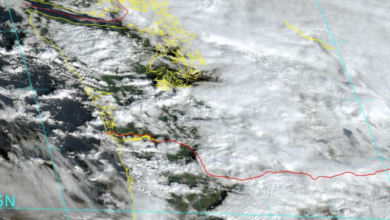📢 Hey, Ho! Biden/Harris Climate Policies Have to Go 📢 – Watts Up With That?

YOU SHOULD SUBSCRIBE TO CLIMATE CHANGE WEEKLY.
IN THIS ISSUE:
- Hey, Ho! Biden/Harris Climate Policies Have to Go
- Video of the Week: The Truth About Islands and Sea Level Rise
- Green Energy Schemes Are the Poor Subsidizing the Rich
- Podcast of the Week: Climate Policy at the GOP Convention: What a Second Trump Term Could Look Like
- New Analysis Ties Whale Deaths to Offshore Wind
- Climate Comedy
- Recommended Sites
Watch ALL the Presentations by the ALL-STARS of Climate Realism at the Archive of Heartland’s 15 Climate Conferences
Hey, Ho! Biden/Harris Climate Policies Have to Go
Meet the new boss, worse than the old boss! At least if you care about energy independence and household security.
As hard as it may be to believe, presumptive presidential replacement nominee, Vice President Kamala Harris, may be worse on climate and energy issues than is her current boss, President Joe Biden. I’ll explain why, shortly, but first a brief discussion of the present state of energy/climate policy.
From the outset, the Biden/Harris administration pushed an all-of-government approach to fighting climate change, which Biden, with Harris’ support and encouragement, has called the only existential threat facing humanity.
The energy policies flowing from Biden/Harris’s climate concerns have cost the people of the United States and the nation itself, dearly.
From day one, the Biden/Harris administration’s energy policies began to undermine the United States’ position of energy dominance. Biden/Harris have blocked and canceled pipelines, oil and gas leases, and lease auctions, and new liquefied natural gas export terminals. They have imposed new, stricter regulations on power plants, vehicles, and oil and gas production. In response to the market chaos and higher prices these policies have produced, Biden/Harris then began draining our various strategic reserves and begged hostile foreign regimes to provide us with energy we could produce at home—all factors which also harm our allies in Europe, who have become increasingly dependent on the United States for critical fuel.
How much have the Biden/Harris administration’s energy policies directly added to U.S. household energy bills? The Heartland Institute has found that over the past three years: residential electricity prices have increased 23 percent; home heating oil prices have increased 69 percent; oil prices have increased 52 percent; natural gas prices have increased 32 percent; and gasoline has increased $0.97 per gallon, or 42 percent.
The result? After three years of Biden/Harris energy policies, the average U.S. driver has spent at least an extra $548 per year on gasoline, and the average household has expended an extra $318 on electricity per year. In sum, since Biden/Harris assumed the office of Imperial Executive—imposing energy policies through regulations and bans, skipping legislative action—the average American household directly paid at least $2,548 in higher direct energy costs from January 2021 through December 2023, meaning the actual added costs of energy have been even greater since prices have continued to rise in the seven months since then.
Also, that doesn’t even count the trillions of tax dollars and deficit spending on climate change boondoggles that reward Biden/Harris’s politically connected green energy profiteers.
Although it is true that the rate of rise in energy prices has fallen in the last year, they are still going up and are much higher across the board than they were under Trump. Indeed, under Trump, oil and gasoline prices fell from Obama/Biden administration levels, and electric power prices were rising at a much slower annual rate than they are now (and the electric power supply was much more reliable with fewer blackouts and brownouts).
And since energy is a factor in almost every good and service, higher energy prices contributed to the rising prices seen in virtually all goods and services, especially food prices, while spurring inflation. So, when you pay more for bread, milk, and other food staples at the grocery store and your paycheck, or food stamps, don’t buy as much as they used to, or when you pay more at restaurants for your meal, you can give an angry, “Thanks a lot, Biden/Harris, for the higher costs, leaving us with less disposable income and fewer choices.”
The repeated chants of “drill, baby, drill,” calls for a return to U.S. energy independence, and sporadic references to the “climate hoax” at the recent Republican National Convention in Milwaukee served notice that Republicans remember what lower fuel prices were like and how they resulted in a growing economy, with good paying jobs, and lower costs for everything else, including food, since energy costs are part of everything.
However, the higher costs resulting from the Biden/Harris energy policies—polices Harris has bragged about—do not respect political affiliation: rather they hurt Democrats, Independents, and Republicans alike.
Indeed, a recent Heartland/Rasmussen survey of likely voters nationwide found that more people support expanding oil and gas production in the country than believe that the Earth is suffering from dangerous climate change, and few people are willing to pay very much to fight climate change.
And it’s not just Republicans that long for more domestic oil and gas production. The Heartland/Rasmussen poll found that more Democrats favor increased domestic oil and gas production than oppose it. Republicans and Independents favor more drilling by and even wider margin.
The fact that a large plurality of Democrats support increased oil and gas production is especially interesting since, according to the same survey, 75 percent of them believe “the [E]arth is experiencing a dangerous level of climate change,” with more than half attributing the dangerous climate primarily to human actions.
If climate change is such an important crisis, one must wonder why so many Democrats support increased oil and gas production, which Biden/Harris and company blame for climate change.
Perhaps they recognize, as Republicans and a large number of Independents do, that the Biden/Harris administration’s climate efforts have not just resulted in higher prices, rippling throughout the economy, but also has resulted in leaving the country economically and geopolitically vulnerable to our competitors and enemies. Or perhaps, like most normal people, they are simply worried about bottom-line pocketbook issues.
As horrible as the impact of Biden/Harris’s climate and energy policies on peoples’ pocketbooks has been thus far, based on her past statements, the climate and energy policies flowing from a Harris/whoever ticket are likely to be even worse. As my colleague Chris Talgo pointed out in a recent article, Harris is even more radical than President Biden when it comes to energy policy.
As attorney general of California, Harris brought multiple lawsuits against oil companies trying to sue them, if not out of existence, at least into subservience to political masters. She’s also been a staunch opponent of offshore oil drilling, called for a complete ban on fracking, endorsed a tax on carbon dioxide emissions, and has thrown strong support to electric vehicle mandates and renewable energy subsidies with the goal of making the U.S. economy “carbon neutral” in just a few decades.
Indeed, Harris’s plans seem less intended to prevent climate change than to assert federal control over the entire economy. The evidence for this is that, as a senator, she was an original co-sponsor of the radical Green New Deal, an effort lead by Rep. Alexandria Ocasio-Cortez (D-NY), which her chief of staff, Saikat Chakrabarti, described as a “how-do-you-change-the-entire economy thing.”
This isn’t a partisan issue. America can’t afford another four more years of Harris/whoever’s energy policies that leave people with less money in their pockets and leave the country vulnerable to the whims of foreign powers.
Sources: The Heartland Institute; Townhall; Heartland/Rasmussen Poll
NEW: Get Climate at a Glance on your mobile device!
Video of the Week
The Heartland Institute’s Linnea Lueken examines the claim that island nations like Tuvalu are threatened with disaster because of modestly rising sea levels associated with climate change. The complicated and non-alarmist truth is here.
Green Energy Schemes Are the Poor Subsidizing the Rich
New research published by the National Bureau of Economic Research finds that the vast bulk of the $47 billion in tax credits for green energy technologies, like electric vehicles, roof-top solar panels, high efficiency appliances, and energy efficient window installations, between 2006 and 2021, have been claimed by households in the highest income brackets. In other words, the subsidies amounted to welfare for the well to do.
As The Daily Caller describes the study’s results, “households in the top 20 percent of earnings nationally received about 60 percent of clean energy tax credits, while the bottom 60 percent of households received just 10 percent.”
The paper is authored by Severin Borenstein, Ph.D., the E.T. Grether Professor of Business Administration and Public Policy at the Haas School of Business and a research associate of the Energy Institute in the Haas School at the University of California–Berkeley, and Lucas W. Davis, Ph.D. a distinguished professor and chair of the Haas Economic Analysis and Policy Group at UC–Berkeley.
With regard to EV tax credits, Borenstein and Davis found the top 20 percent of earners claimed 80 percent of the tax credits, with those in the top 5 percent of incomes garnering about 50 percent of the credits by themselves. Seriously, billionaires and multimillionaires need tax credits to purchase electric vehicles?
Indeed, the study found limited “correlation between greater green tax credits and the adoption of technology such as heat pumps, solar panels, and EVs.”
“The cost effectiveness of tax credits hinges on their ability to increase adoption of clean energy technologies,” the study noted. “Overall, we find little correlation between tax credits and technology adoption.”
This means, in short, the rich claimed tax credits they didn’t need, since they would likely have bought the green energy tech without them. Increasing various green energy tax credits did not increase or broaden adoption. The poor who couldn’t afford (or didn’t really desire the technology) before the credits, still couldn’t afford them (or didn’t want them) after support was increased. For heat pumps, for example, the authors concluded:
[A] credit was introduced in 2006, yet adoption decreased in that year. The credit was not available in 2008 and 2018, but there is no discernible decline in heat pump shipments during those years. Moreover, during 2009 and 2010 the credit increased from 10% to 30%, yet there is no pronounced increase in heat pump shipments those years.
Sources: The Daily Caller; National Bureau of Economic Research
Heartland’s Must-read Climate Sites
Podcast of the Week
As the Republican National Convention in Milwaukee closed, we look at the climate and energy platform of the party. Do they differ from Trump’s first-term agenda? What is the stance of VP candidate J.D. Vance on the topic considering Trump has tapped Vance to carry his MAGA agenda forward? To talk about all this – plus the Crazy Climate News of the Week – we have as our guest Steve Milloy of JunkScience.com who was a member of the EPA Transition Team for the first Trump presidency.
Subscribe to the Environment & Climate News podcast on Apple Podcasts, iHeart, Spotify or wherever you get your podcasts. And be sure to leave a positive review!
New Analysis Ties Whale Deaths to Offshore Wind
A story in The Daily Mail references new research concerning the increase in whale deaths off the eastern coast of the United States. The research strongly indicates that the timing and number of whale deaths so closely correlates in time and location to the commencement of and expansion of sonar mapping for industrial offshore wind projects that the scientist undertaking the research says with confidence, “Absolutely, 100 percent, offshore wind kills whales.”
Apostolos Gerasoulis, a Rutgers University professor emeritus of computer science, who co-created the search engine that powers Ask.com, was shocked by the uptick in whale and marine mammal deaths in recent years and developed a software system to “identify any relationship between the dead whales and offshore wind survey vessels, which use loud blasts of sonar to map the seabed for the installation of offshore wind turbines and high-voltage cables.” He named the system Luna, in honor of a popular humpback whale researchers tracked migrating up and down the eastern seaboard for nearly 50 years, but which had washed ashore, dead, recently.
Beginning in 2016, the National Oceanic and Atmospheric Administration declared “unusual mortality events” for humpback whales and in 2017 for minke whales and North Atlantic right whales, when deaths of the species spiked after years of stable or flat mortality. Since 2016, 534 of those species of whales have died; many hundreds and perhaps thousands of more marine mammals, including dolphins and porpoises, are also believed to have died over the same time period.
The spike in deaths corresponded to the commencement of broad sonar mapping of the U.S. East Coast in anticipation of the construction of offshore wind farms, beginning in 2016. These vessels send out loud, high-intensity sonar blasts to map the ocean floor to determine suitable locations for offshore wind farms turbines. The Daily Mail notes:
The underwater noise is loud. On May 8, 2023, Robert Rand, a veteran acoustical consultant conducted a study of the sonar noise generated by the Miss Emma McCall survey vessel off the coast of New Jersey.
The following January, he testified at a Congressional hearing about his findings.
Rand found that the sound was 224 decibels at the source. As sound waves travel away from the source, volume diminishes. But a half nautical mile away, Rand measured peak sound levels at 151.6 decibels.
The National Marine Fisheries Service, part of NOAA, says that whales and other marine mammals can temporarily lose hearing at 152 decibels of continuous sound and can permanently lose hearing at 173 decibels.
Commenting on those findings, a conservation biologist interviewed for the story, Trisha DeVoe, told The Daily Mail:
There’s a saying that a deaf whale is a dead whale. Because if the whale can’t hear, it can’t see to navigate. The depths of the ocean are very dark, and they rely on their hearing to know what’s around them.
If all of a sudden there’s this incredibly loud, disturbing noise that could even be painful to them, they’re going to run away. So we think that it could be deafening them or causing them to flee, and then maybe putting them in harm’s way.
Gerasoulis’s software seems to confirm the thought that high frequency solar blasts are harming whales.
NOAA data show that whale deaths off the coasts of New Jersey, New York, and Rhode Island jumped five-fold, from an average of two per year before 2016 to 10 or more per year in the years since, with 21 humpback whales dying in the region in 2023 alone.
The Luna system plots whale deaths, accounts for wave action, and tracks the mileage and paths logged by survey ships as they travel zigzag courses during mapping, generating a system of maps that display the locations of whale deaths alongside the routes taken by various survey ships. The Daily Mail described some of the specific results:
[F]rom 2017 through 2023, a total of 286 whales, dolphins, and porpoises died along the New Jersey and New York shores. Luna shows exactly where they were found.
Luna visually displays the zigzag routes taken by offshore wind survey vessels. During January and February 2022, there was little survey boat [traffic] in the area. Six vessels traveled a total of 4,213 miles. One humpback whale died.
January and February 2023, however, showed a tremendous increase in survey vessel traffic in the waters off New Jersey and New York – 13 vessels traveled a total of 11,977 miles. Seven humpback whales died, including Luna.
In August 2022, survey boat traffic was minimal off the New Jersey coast. Two survey vessels worked near Asbury Park and two more worked off Atlantic City. They traveled a total of 5,469 miles. There was plenty of open water around the two survey areas and no humpback whales died.
August 2023, however, was a different story. Sixteen different offshore wind survey vessels moved slowly back and forth off the coast. They covered a total of 16,812 miles, triple the amount of the previous August. Six whales died that month.
Gerasoulis also accounted for the increase and decline in ship traffic during the survey period and found there was no correlation between increased ship traffic and increases in whale deaths.
To test the robustness of Luna’s connection between whale deaths and offshore wind activities, Gerasoulis put the data through two statistical analyses. He divided his data into the number of humpback whale deaths from 2006 to 2015 in the areas of study, and the number of whale deaths after 2016 when offshore wind surveys were underway. Both analyses confirmed “that the difference in whale deaths before and after offshore wind surveys started was statistically significant and not random.”
Based on these results, Gerasoulis says NOAA should rethink its claim that wind facility siting and construction activities are not harming marine mammals.
“It is the cumulative impact of multiple offshore wind boats surveying in a small region where the whales are feeding that is affecting the whales,” Gerasoulis told The Daily Mail. “NOAA needs to investigate.”
Source: The Daily Mail
Climate Comedy
Recommended Sites
Related














